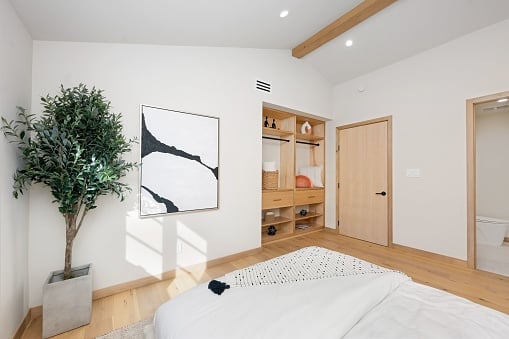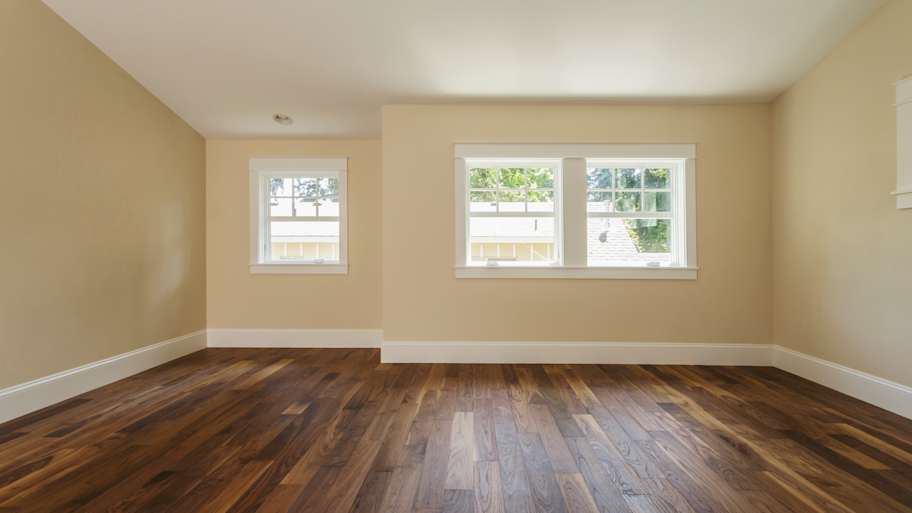
Get expert insights on stair railing repair cost, including average prices, cost factors, and tips to save money. Plan your stair railing repair project with confidence.
Cover all your bases with this need-to-know info


MDF baseboards are less expensive than wood, but don’t last as long.
Wood baseboards have a long lifespan because it’s easy to repair small damages.
Consider PVC alternatives for high-humidity areas, as both wood and MDF baseboards don’t tolerate moisture.
Baseboards are sometimes an afterthought when it comes to home improvement, so it’s no surprise that lots of folks don’t know which material to choose. Two popular options you may consider are medium-density fiberboard (MDF) baseboards and wood baseboards. Though the two look similar at first glance, they couldn’t be more different in everything from versatility to durability. So, when it comes to MDF baseboards versus wood, which should you choose? Here are all the pros and cons of each option, as well as how they stack up against each other.
The biggest difference between these two types of baseboards is how they’re made. Wood baseboards are crafted from real hard or softwood—usually pine, oak, ash, or poplar—and have a visible wood grain that doesn’t necessarily need treatment beyond staining.
By contrast, MDF baseboards are a composite of wood fibers, don’t have any aesthetic value on their own, and will need to be primed and painted before they can frame your walls. What’s more, baseboards made from this material aren’t as strong as their pure wood counterparts, which can be both a benefit and a drawback. For instance, their added flexibility makes for easier installation, but their flimsy nature will make them more susceptible to damage in the long run.
MDF are a composite of wood fibers. They’re made through a process of breaking down small branches and other lumber byproducts into a fine pulp that’s then reformed into a solid final product—but not as solid as real wood. Using this material can lower baseboard installation costs, but it’s also unlikely to last as long as the alternative due to its reduced durability.
| Pros | Cons |
|---|---|
| Easy installation | Low durability |
| Inexpensive | Hard to repair |
| More customizability | Damages easily |
Best for:
DIY projects on a budget
Rentals or other short-term stays
Low-traffic areas
MDF baseboards are a great pick for those looking to cut costs or who plan to do a DIY installation. Per linear foot, you’ll pay as little as $1 and up to $1.40 on average. This material also bends easily, making it ideal for squeezing into tight corners. Plus: It’s not brittle like real wood, so you don’t need to worry about it cracking when nailed, and you can paint and repaint it to your desires without needing to sacrifice a beautiful wood grain.
Despite being the more economical choice, there are a number of downsides to consider with MDF baseboards—namely that its use of less expensive materials also makes it less likely to stand the test of time. Those who’ve used it report chipping after just a few months to a year of use, especially when installed in high-traffic areas where damage is more likely to occur in the first place, or in humid spaces like bathrooms, where the high moisture levels will cause it to warp fairly quickly.
Unlike real wood, repairing it is difficult and often costs more than making a replacement. Other concerns to keep in mind include the fact that it emits an extra-fine dust when cut that can pose health hazards.

There are two kinds of wood baseboards: hard and softwood. Softwood options made from things like pine are easier to install and less expensive than hardwood varieties like oak and ash, yet also have the beautiful wood grain that’s such a draw. Another important difference between these two types is how they’re treated—hardwood should be left natural or, at most, stained, while painting is possible on softwood options.
| Pros | Cons |
|---|---|
| Long lifespan | Costly |
| Painting not required | DIY installation more difficult |
| Durable | May split when nailed |
Best for:
High traffic areas
Long-term stays
Those in search of a natural wood look
The biggest benefit of wood baseboards is their long lifespan. You’ll get up to a few decades of use out of them compared to just a little more than one decade from MDF baseboards. Any damages that do occur in that time are relatively easy to repair, since real wood can be sanded to remove dents and chips and restained as necessary. Real wood also has an aesthetically appealing grain that can be left raw or stained, but doesn’t need to be painted or primed.
While wood baseboards have better durability than options made from MDF, you’ll pay for the extra quality. Softwood options are only marginally more expensive at between $1.40 and $2.50 per linear foot, whereas hardwood varieties can cost up to double that of MDF baseboards.
There’s also the issue of installation, which is harder to do yourself with real wood baseboards because of their limited flexibility—and the fact that their brittle texture is more likely to split when nailed. The good news is it’s not hard to find a baseboard contractor near you who will have the right tools and know-how to set them up without issue.
Finally, wood baseboards are only slightly more tolerant of humidity than MDF baseboards. They won’t warp as quickly, but will be gradually affected over time—and buckled wood is one of the few damages that can’t be easily fixed the way a chip or a scrape can. For spaces with high moisture levels, like bathrooms and kitchens, consider other baseboard varieties that are made with water-resistant materials like PVC or polystyrene.
Now that you know what’s great and what’s not about these two options, here’s where they stand in the most important categories.
When it comes to looks, there’s no clear winner because your personal preferences play a big role. Wood options are ideal for those who prefer an earthy, natural look, while anyone hoping to add a bright pop of color to their baseboards might be better off with an option made with MDF.
Wood baseboards have a lot of things going for them, but versatility is not one of them. By contrast, MDF baseboards are more flexible and can better fit tight corners or unique curves, and they can be painted to suit a whole host of preferences.
MDF baseboards are versatile, but they’re also flimsy, and definitely aren’t suited to defend against the rough and tumble nature of a high-traffic area. Wood baseboards take the crown in this category for being hard to damage in the first place and easy to repair if or when they break.
While it’s possible to find wood baseboards at a reasonable price, MDF options can’t be beat for budget baseboards.
Installing pure wood baseboards can be tricky, but the same is not true for MDF baseboards. Flexible and lightweight, the latter are easy to install no matter your level as a DIYer.
All you need is a bit of sandpaper and wood stain to make a scraped wood baseboard look good as new. However, sanding will only further damage MDF baseboards, and fixing such options will require a whole host of tools—like wood glue or filler—that may end up costing you more to repair than replace.
You’ll get up to several decades of use out of wood baseboards, while MDF baseboards can last at most a little more than a single decade.
Wood baseboards are less hazardous to prep and install—they don’t emit harmful, super-fine dust, for example—and can be recycled when they’re no longer good enough to use.
From average costs to expert advice, get all the answers you need to get your job done.

Get expert insights on stair railing repair cost, including average prices, cost factors, and tips to save money. Plan your stair railing repair project with confidence.

Installing trim can give your home a finished, polished appearance. Learn how much it costs to install trim and what factors affect how much you’ll pay.

Get a clear estimate of the cost of a custom desk, including average prices, key cost factors, and tips to help you budget for your home office project.

Learn how to measure baseboard trim of any style or size to help speed up installation, save on materials costs, and look amazing anywhere in your home.

Learning how to install crown molding on a vaulted ceiling is challenging, but not impossible. Follow the steps in this guide to discover the necessary cuts.

Wood trim ties rooms and living spaces together beautifully. Learn the best wood for baseboards that blend durable edges with designer vibes.